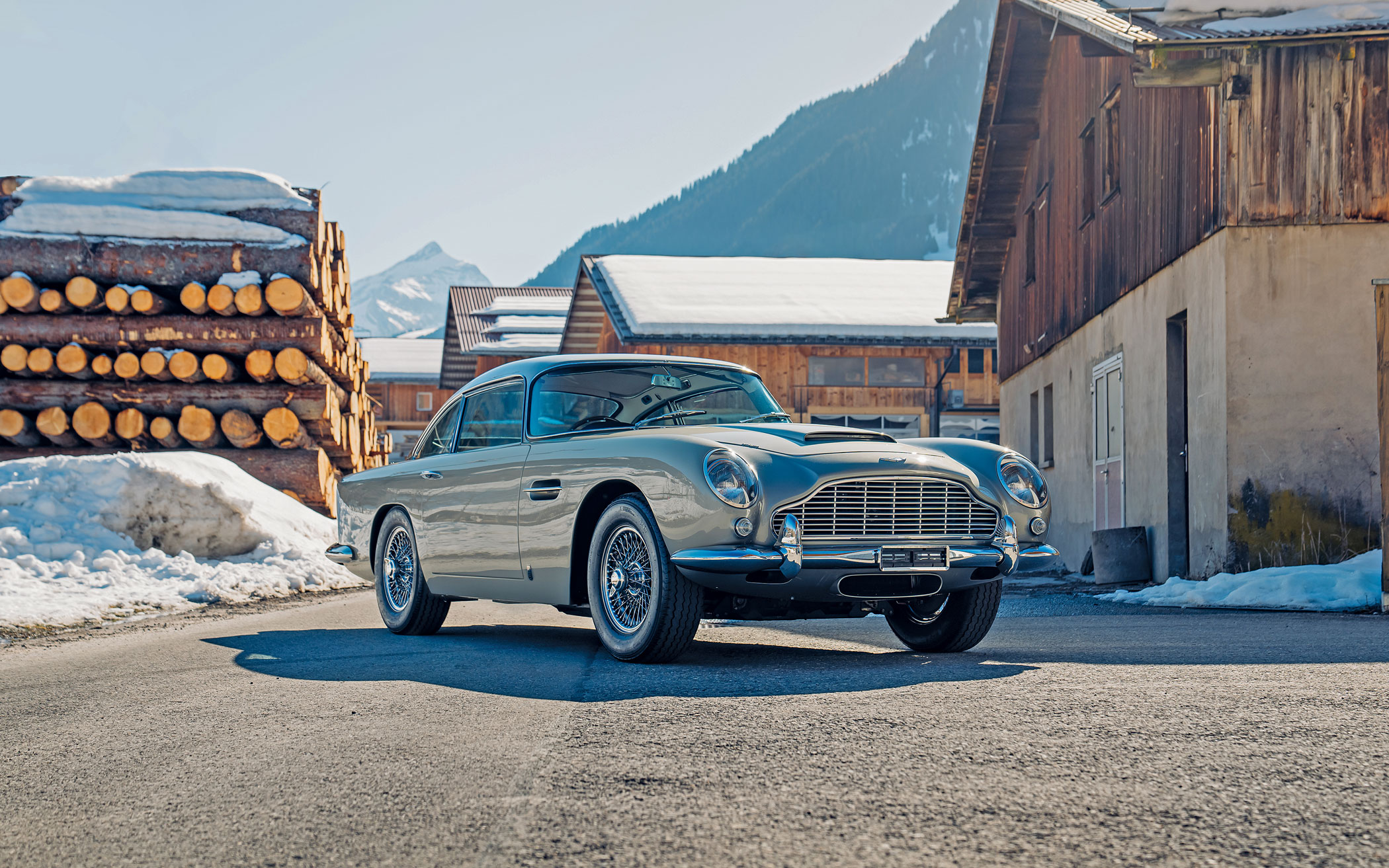SCM Analysis
Detailing
| Vehicle: | 1964 Aston Martin DB5 |
| Years Produced: | 1963–65 |
| Number Produced: | 886 coupes (plus 123 convertibles and 12 station wagons) |
| SCM Valuation: | $778,000 |
| Tune Up Cost: | $1,000 |
| Chassis Number Location: | Plate on right side of cowl |
| Engine Number Location: | On left of cylinder block next to alternator |
| Club Info: | Aston Martin Owners Club |
| Website: | http://www.amoc.org |
| Alternatives: | 1965–68 Ferrari 330 GT 2+2, 1957–65 Maserati 3500 GT 1966–68 Lamborghini 400GT |
| Investment Grade: | A |
This car, Lot 18, sold for $2,425,000, including buyer’s premium, at Broad Arrow Auctions’ Monterey, CA, sale on August 18, 2022.
Of the many promotional photographs taken of Sean Connery as Agent 007 during the production of “Goldfinger,” one of the most memorable depicts him parked off to the side of the Furka Pass looking as we think of him: poised, confident and impeccably dressed. He is leaning against the fender of his gadget-laden Aston shortly before Tilly Masterson’s failed attempt at killing Goldfinger sets in motion one of the most memorable movie chase scenes of all time.
Thanks to the massive success of the film (its $3 million budget was recouped in two weeks), the DB5 has arguably become the most famous movie car ever. Even DB5s without any cinematic provenance have become highly esteemed acquisitions, with prices that have steadily crept toward the $1 million threshold for standard models (and well beyond for Vantage and Volante versions). Apart from buyers’ James Bond fantasies, it’s not hard to see why: Together with their contemporary 2+2 competitors from Ferrari and Maserati, these GTs defined an era. They were sexy-yet-serious transports that could travel from one European capital to another in speed, style and reasonable comfort.
The DB bloodline
The DB5 inherited a legacy that began with David Brown’s 1946 acquisition of struggling Aston Martin for £30,000 (about $1.6 million today). Flush with cash from wartime machining and tractor manufacturing, Brown went on to purchase Lagonda (for not much more than he spent for Aston Martin) and with it the rights to a new 2.6-liter DOHC straight-6 developed by William (Willie) Watson under W.O. Bentley.
These ingredients were successfully melded to create the attractive DB2, which would eventually mature into the more advanced DB4. That car featured a gorgeous Touring-designed body (constructed using Touring’s Superleggera technique) which was wrapped around an all-new, all-alloy 3.7-liter straight-6. Introduced in 1958 and continually improved until it went out of production in 1963, the DB4 was considered one of, if not the best, 4-seat GTs of its era. Handsome looks, spirited performance and superb build quality ensured it was more than a match for any Ferrari or Maserati 2+2.
Its successor, the DB5, was in essence an evolution of the final Series V DB4, and was launched in 1963 with an enlarged, 4.0-liter version of the engine, enhanced with three SU carburetors and capable of 280 horsepower (or up to 325 in Vantage trim). Just over 1,000 units were produced. Of this, only 123 were convertibles, their small numbers presumably responsible for their valuations, two or three times that of the coupe.
Delayed gratification
Given the role that the Bond films played in propelling Connery to superstardom (not so many years earlier he had been playing opposite leprechauns in “Darby O’Gill and the Little People”), it’s probably not surprising that he purchased a DB5 for his own amusement, though he delayed that gratification until late in life. The car he selected, DB51681R, was first registered to Cyril Williams Motors of Wolverhampton, U.K., on July 8, 1964. After passing through a succession of owners, it eventually surfaced in somewhat worn but unmolested condition at Bonhams’ 2005 Silverstone sale (in Sierra Blue paint, no less) showing 52,000 miles. The sale price? Just $73,920 (SCM# 39919).
Fast-forward to 2018, when Sir Sean acquired the car (apparently because of its condition and known history), now looking much more Bond-like in Snow Shadow Grey over red Connolly leather following an extensive restoration. Sadly, Connery had little time to enjoy the car before his death in October 2020.
“This is gold, Mr. Bond”
Unlike almost any other car, the DB5 market seems to be bifurcated into cars connected to Bond films — and everything else. In 2019, a DB5 built to promote “Thunderball” (but not used in the film) sold for an impressive $6,385,000 at RM Sotheby’s 2019 Monterey auction (SCM# 6908532). While our subject car doesn’t have quite the same movie-prop provenance (nor any gizmos), mentioning Sean Connery as your DB5’s previous owner has definite mic-drop potential.
Yet at a time when documentation and originality seem increasingly critical criteria in the sales of premium classics, perhaps this car’s sale price of $2.4m (versus an estimate of $1.4m–$1.8m) was held back a bit by its color change. Regardless, it’s a new benchmark for a standard DB5 coupe without any direct movie affiliation and portends further pricing updrafts for these undeniably sexy coupes.
Those unwilling to wait for an actual piece of Bond-related history can instead avail themselves of an Aston-built Goldfinger continuation model that lists for a mere $3.6 million. Though its machine guns flash LEDs rather than firing bullets and its rear defenses spray water rather than oil, you can always comfort yourself with the protection of a rear bulletproof shield and front and rear bumper rams. ♦
(Introductory description courtesy of Broad Arrow Auctions.)



